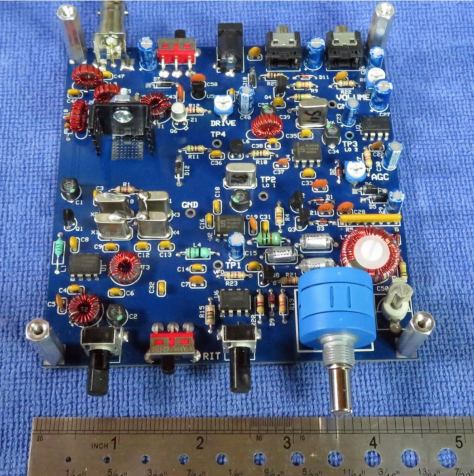Many thanks to Sam (WN5C) for sharing the following guest post:
Homebrew in the Field
by Sam (WN5C)
What a week it’s been!
I have the opportunity to spend a month traveling through and camping in the American Southwest (specifically, New Mexico, Arizona, and Colorado) doing archaeological work. And of course, that means the prospect to operate portable at weird times and in lots of places.
I’ve been planning for this trip for a couple of months, about the same length of time that I’ve been trying to achieve my amateur radio dream: to build a complete transceiver. So why not try to do both things at once?
This is just a quick note of my experiences in the first quarter of my trip of taking a homebrew rig into the field.
 First off, I have absolutely no background in RF engineering, or electronics at all. But the literature is good and Elmers are priceless (thanks Kenn KA5KXW!). I started small, with kit projects, and then very basic transmitters.
First off, I have absolutely no background in RF engineering, or electronics at all. But the literature is good and Elmers are priceless (thanks Kenn KA5KXW!). I started small, with kit projects, and then very basic transmitters.
I’ve always appreciated how much satisfaction my father gets by building things by hand, and finally I have a similar hobby. I called the radio I designed the Thunderbird Mk 1 based off the fact that I cut my CW and POTA teeth at Lake Thunderbird State Park in Oklahoma and will probably continue to work there the most. It’s a 6-band (40, 30, 20, 17, 15, 10) CW QRP transceiver with SSB receive.
The receiver is direct conversion and is an amalgamation of VU2ESE’s DC40, KK7B’s Classic 40, and W7EL’s Optimized QRP Transceiver. The VFO is an Arduino/si5351 combo based on the schematics and code written by VK3HN (who has helped me from afar, thanks Paul!). It’s crude, but I use a 6-position rotary switch to manually switch between the band-pass filters.
The transmitter is based on W7ZOI’s Updated Universal QRP Transmitter, married with VK3HN’s Arduino code that acts as the oscillator, keyer, and side tone generator. I get about 3 watts output for 40, 30, 20, a little less for 17 and 15, and about a watt on 10 meters. Like the receiver, I manually switch the low-pass filters.
Here’s a picture of the digital parts (ignore the second Arduino Nano, I thought I would need it but did not), the power board, and the filters. It’s on the bottom:
 On top is the main board with the receiver, the transmitter, and T/R switching. Also, you’ll notice the green PCB. I *really* wanted to build NM0S’s Hi-Per-Mite from scratch but I couldn’t get the circuit to run right before my trip so I opted to install one that I built from a kit. It’s a fantastic CW audio filter that I can switch in and out (everyone should have at least one!).
On top is the main board with the receiver, the transmitter, and T/R switching. Also, you’ll notice the green PCB. I *really* wanted to build NM0S’s Hi-Per-Mite from scratch but I couldn’t get the circuit to run right before my trip so I opted to install one that I built from a kit. It’s a fantastic CW audio filter that I can switch in and out (everyone should have at least one!).
 I can switch in a little speaker and added a straight key jack. I printed the box on a 3D printer at the local library. It works great for the shack. In the sun, it’s starting to warp in the heat, so I’ll have to address this, but things still work!
I can switch in a little speaker and added a straight key jack. I printed the box on a 3D printer at the local library. It works great for the shack. In the sun, it’s starting to warp in the heat, so I’ll have to address this, but things still work!
Getting out the door on time with a finished radio was tough! I had finished right before I left on my trip (end of May 2024) and had no time to field test. The best I got was taking the rig to the table in the back yard and firing it up during the WPX contest.
I made amazing DX contacts on all the contest bands I had and called it good. But working superstations isn’t real life, and over the next week I’ve had to MacGyver the radio (rigging a car jump pack, an inverter, and a soldering station together at a picnic table to replace a bad transistor, for example). I think I’ve finally shaken out (literally) all of the loose solder joints and bad grounding. Continue reading Sam’s Thunderbird Mk 1 Takes Flight: A Homebrew Radio Field Report from the American Southwest






















